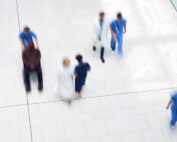Trends, Entrants, and Developments (TEDs) Impacting Access: Practices Payers Are Leveraging to Bend the Cost Curve
Good day to you. I am Elizabeth Oyekan, PharmD, FCSHP, CPHQ, Vice President – Access Experience Team, and editor of All Access Newsletter. Due to the significant financial losses by health systems over the last 18 months, and now health plans experiencing adverse impacts to their bottom line as patients come back in for care, these entities are looking for strategies to make up for these losses now and in the future.
In this edition of the All Access Newsletter, we have asked our key expert ex-payers to provide insights into evolving practices payers are leveraging to bend the cost curve.
- Cynthia Miller, MD, MPH, FACP and Reta Mourad, PharmD discuss the importance of biosimilars in supporting the sustainability of the healthcare system by reducing costs of biological therapies through increased competition while maintaining the quality of care
- Jennifer Williams, PharmD, BCOP reviews the top reasons payers are adopting clinical pathways and guidelines in the oncology space and the tumor types being targeted, as well as future possibilities payers are exploring in non-oncology specialties to further leverage pathways and guidelines
- Todd Edgar, PharmD, MS takes us into the world of value-based contracting with new perspectives on how these contracts should be viewed, learnings from past years, and opportunities to make them a win-win for stakeholders
- Kellie Rademacher, PharmD explores the complex world of biomarker testing including the several testing options available, the expansion of biomarkers, and the resulting challenges for various stakeholders. Kellie highlights possible policy recommendations to help payers and providers address existing challenges and support stakeholder efforts in their pursuit of precision medicine
- Ryan Cox, RPh, MBA takes us into the world of accumulators and maximizers being used by pharmacy benefit managers (PBMs) and health plans as a result of a continued pressure between plan benefit design, the expansion of manufacturer copay programs, and the growth of drug spending. Ryan discusses what they are, how they work, and their impact on various stakeholders
We believe you will find these current and evolving payer practices to bend the cost curve in healthcare and their impact on access insightful as you navigate the payer landscape. As always, please feel free to drop me a note and let me know if you have a topic suggestion for the payer team to address, and we’ll do our best to cover it in a future edition.
Best regards,

Elizabeth Oyekan
PharmD, FCSHP, CPHQ
Vice President,
Access Experience Team
EMAIL ELIZABETH
All Access is a bimonthly newsletter that features key insights from our team of former payers, intended specifically for market access leaders. It is published by PRECISIONvalue.
Guest Editor
Elizabeth Oyekan
Executive Editor
Louis Landon
Contributors
Andrew Cournoyer
Ryan Cox
Dan Danielson
Todd Edgar
Dominic Galante
Ami Gopalan
Maureen Hennessey
Joe Honcz
Louis Landon
Erin Lopata
Reta Mourad
Kellie Rademacher
Charline Shan
Drug Pricing Reforms: Perspectives on Federal and State Efforts
Ryan dives into the drug pricing reforms at both the federal and the state level. He reviews the potential unintended consequences of the IRA on innovation. He also delves into legislation at the state level that is being developed to manage drug spend, including Prescription Drug Affordability Boards and drug importation.
Copay Smoothing for Medicare Enrollees: Potential Impacts for Plans and Pharmaceutical Manufacturers
Dan discusses the copay smoothing provision of the IRA and the potential impact on Medicare drug plans. In addition, he proposes several ways that pharmaceutical companies can educate consumers and providers on copay smoothing to improve drug uptake and adherence.
The IRA: Evolving Toward Pharmacoequity
Maureen introduces the concept of pharmacoequity and the IRA’s potential positive and negative impacts on it. She provides solutions for payers and pharmaceutical companies to improve health equity and promote pharmacoequity.
Two Unintended Consequences of the IRA We Aren’t Talking Enough About
Andrew discusses two unintended consequences of the resulting from the Inflation Reduction Act (IRA). In this article, Andrew highlights the IRA’s small manufacturer exemption that aims to provide financial protections, yet could actually imposes access obstacles. Additionally, he details how the Medicare Part D redesign has negatively impacted plan offerings and its resulting effect on beneficiary choice.
Future of Research and Development in Oncology
In 2023 the FDA approved 55 novel therapeutics, the second highest count in the past 30 years. This included 16 oncology approvals, including 4 novel bispecific antibodies, which contain multiple sites for 2 different antigens. New oncology clinical trial starts are at historically high levels. The next-generation biopharmaceuticals pipeline is robust and full of promise for patients with cancer, with many CAR T-cell, NK-cell, and gene therapies and cancer vaccines in development.
Care Pathways and Oncology Access
The use of cancer care pathways aims to improve patient outcomes by prioritizing provider prescribing to high-value evidence-based treatments and therefore reduce the use of expensive therapies that could be more toxic and/or marginally effective. With the rapid development of new treatments in oncology, especially in targeted therapies and immunotherapy, and the increase in cancer care options, it can be difficult for oncologists to keep up with the evolution of prognosis, available medications, and their potential side effects. The addition of care pathways may be a way to provide physicians with a comprehensive and clinically relevant decision support tool.
Oncology Biosimilars
Biosimilars for oncology products and supportive agents have been on the market longer than any other class of biosimilars, with the first being a filgrastim biosimilar approved in 2015. There are now multiple biosimilars for filgrastim, pegfilgrastim, bevacizumab, trastuzumab, and rituximab. Payers have reported a significant decrease in cost per claim of oncology products that have biosimilars since 2019 with decreases in cost per claim between 33% and 39%. While oncology biosimilar uptake was initially slow, biosimilars for bevacizumab, trastuzumab, and rituximab now make up more than 73% of the market share through 2022.
2024 Update on the Enhancing Oncology Model (EOM)
One year after the end of the Center for Medicare and Medicaid Innovation’s multiyear Oncology Care Model (OCM), its successor program, the Enhancing Oncology Model (EOM), began on July 1, 2023. EOM is a voluntary 5-year model in which oncology practices assume risk and accountability for their Medicare patients’ health quality and total spend during 6-month episodes of care. Episodes begin with initiation of systemic chemotherapy for the 7 cancer types in which the Centers for Medicare and Medicaid Services (CMS) saw the greatest reductions in total episode payments under OCM: high-risk breast cancer; lung, prostate, and small intestine/colorectal cancer; lymphoma; chronic leukemia; and multiple myeloma.
All Access: 2024 Trends in Medicare Advantage
Finally, Karina gives us a view into the changes for Medicare Advantage into 2024. As this segment of health insurance continues to grow, it may have growing influence on access to therapeutics. She provides several strategies to ensure manufacturers stay abreast of changes and position themselves favorably.
2024 Trends in Behavioral Health
An overarching theme throughout the health care ecosystem—including behavioral health—is that within a landscape fraught with post-pandemic and economic transitional uncertainty, patients and their care partners expect health care stakeholders to simplify complexity, help manage risks, and solve their problems. A 2023 Bain survey, and an NEJM article, “Health Care 2030: The Coming Transformation,” are calling for the abandonment of traditional perspectives, and adoption of transformative mindsets and systems focused on providing solutions and offering personalized, preventive care for populations.
The Future of the 340B Program
The Public Health Service Act 340B Drug Pricing Program enables providers that serve vulnerable patient populations to access outpatient drugs at significantly lower costs, which helps improve overall patient care. Since the Medicaid Drug Rebate Program and the 340B Drug Pricing Program were established in the early 1990s, stakeholders have struggled to resolve questions surrounding duplicate discounts. Expanding these programs under the Affordable Care Act in 2010 exacerbated the issue and further complexity will be added through the Inflation Reduction Act.
Forecasting Payer Actions in the Unknown World of IRA
American author H.P. Lovecraft wrote that “the oldest and strongest emotion of mankind is fear, and the oldest and strongest kind of fear is fear of the unknown.” And unknown territory is where we are heading when it comes to forecasting payer actions in response to the impending liabilities and costs stemming from the Inflation Reduction Act. What we know for sure, however, is that payer liability is increasing.
Will the US Move Away from Interchangeable Designations for Biosimilars?
On September 15, 2023, the Food and Drug Administration released draft guidance entitled “Labeling for Biosimilar and Interchangeable Biosimilar Products.” The agency is accepting comments through November 17, 2023, and the finalized guidance will revise and replace the 2018 guidance for the industry entitled “Labeling for Biosimilar Products.”
How the Enhancing Oncology Model and Inflation Reduction Act May Affect Price and Spend
Ryan dives into the combined effects of the Enhanced Oncology Model (EOM) and the Inflation Reduction Act (IRA) on the healthcare market. He discusses the potential unintended consequences for pharmaceutical companies.
The Future of Prior Authorization and Reform
Jennifer tackles the changing landscape of prior authorization from increased payer pressure to relieve provider and patient burden coupled with the rising payer spend on pharmaceuticals. She gives solutions for how pharmaceutical companies can handle the downstream consequences of prior authorization reform.
Biosimilar Pricing Strategies
Molly discusses the complexity of pricing, contracting, and market share around the new adalimumab biosimilars, and the strategies payers will use to maximize the cost savings on the pharmacy benefit. She provides several suggestions for pharmaceutical companies that are entering the biosimilar space.
Hospital at Home Care Models
Janet discusses the growing hospital at home (H@H) care movement that ramped up during COVID. She reflects on how hospitals will adjust to this new trend and its financial sustainability, as well as how it fits into the value-based care landscape. Finally, she presents opportunities for pharmaceutical companies to engage in this new care delivery model.
Potential Expansion of CMS’s Site-neutrality Payment Policy and Its Impact
Kris discusses CMS’s new site-neutrality payment policy, which is a major focus for AHIP. While this may be a win for payers, there are considerable risks for hospital systems, and it may have long term impacts on consolidation trends. Impacts on specialty pharmacy and site of care strategies will change how pharmaceutical companies need to convey their value story.
Transitions of Care/Home Health: New Models in Value-Based Care
Sejal describes novel approaches to the long-standing problem of health care system fragmentation and transitions of care. New partnerships and disruptors like CVS and Signify Health, Good Rx, and Amazon are attempting to solve for fragmentation as it can lead to poor medication adherence and outcomes. Pharmaceutical companies can also be a leader in this space. Sejal provides recommendations on how manufacturers can support payers and improve the transition planning process.
The Future of Rural Health Care in the US
Barbara dives deeper into rural hospital closures and the growing rural health care crisis. She discusses new payer policy approaches as well as efforts in the virtual care and digital tool space. She concludes her article with insightful suggestions for pharmaceutical companies to partner with payers in addressing this growing health care gap.
Care Delivery Changes and Challenges after the Public Health Emergency
As we move into this post-pandemic phase, it is important to consider how the end of the PHE will impact care delivery and patient care now that certain provisions that allowed for expanded, easier access to care may or may not remain in place. Many hospitals, providers, and caregivers continue to deal with the challenges of workforce shortages and financial pressures, cost increases for medications and equipment, supply chain issues, and sicker patients.
Post-PHE Medicaid Disenrollment and Employer Group Enrollment Impact
As you may have heard, the COVID-19 Public Health Emergency (PHE) and national emergency (NE) are coming to a close on May 11, 2023. The focus of this article addresses the potential impact to commercial/employer plan enrollment shifts as a result of the unwinding of Medicaid continuous coverage protection.
Shortages All Around: The Implications of Staff Shortages and Rural Hospital Closures on Access to Care
Staffing shortages are not new. For years, the industry has been predicting a shortage of physicians and nurses, particularly in rural areas, and there have been calls to expand scope of practice for nurse practitioners, physician assistants, and pharmacists as a result. Enter COVID-19, and staffing shortages accelerated. Physicians, nurses, and other care providers began exiting the job market because of insufficient resources and burnout.
Beyond the PHE: Forging a More Resilient Future
Three years into the pandemic, a recent Lancet editorial observed, “The acute months of the COVID-19 pandemic motivated an unprecedented response from governments, international organisations, pharmaceutical companies, and civil society.” As we transition to a different phase of this pandemic, the need for multistakeholder collaboration continues, to build resilience and prevent or mitigate future pandemics.
The Growing Emergence of Biosimilars
After a slow start since the first US biosimilar came to market in 2015, there has been a significant increase in approvals and launches. To date, 41 have been approved in the US, with over 90 biosimilars in development. Additionally, in the upcoming months, several biosimilar launches are anticipated to meaningfully impact formularies and pharmacy benefit specialty drug spend.























